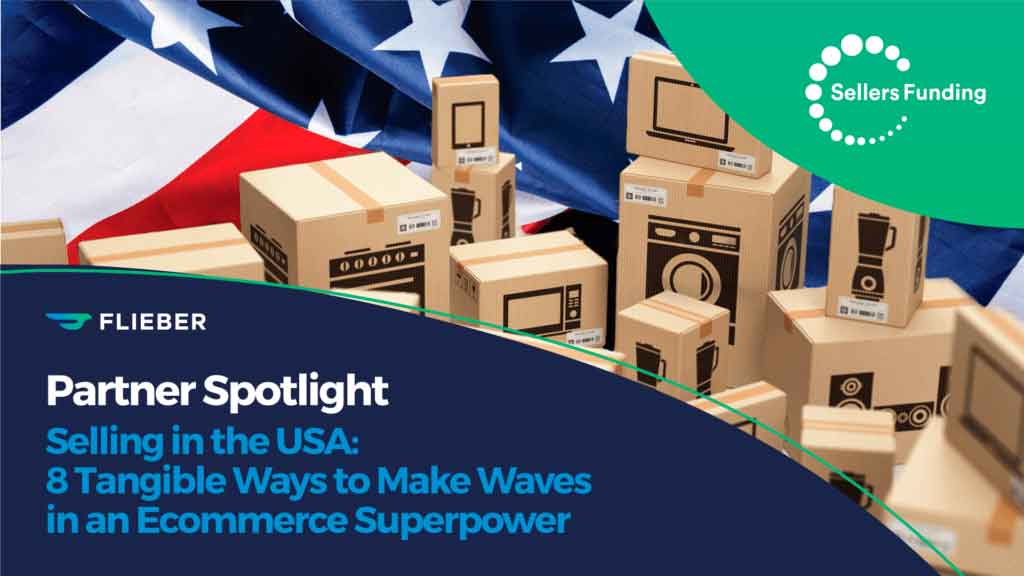www.sellersfunding.com
Selling in the USA has become ultra-profitable over the years, But there’s a knack to making it work. Join us as we share the secret recipe
If you’re an ambitious eCommerce entrepreneur, there’s a growing list of reasons to add the US to your selling location wish list.
The US eCommerce market is currently the second-biggest economy in the world, standing at a brag-worthy $432 billion, and is expected to show an annual growth rate of 4.68% from 2021-25.
That means there are a ton of opportunities ready for you to snap up.
In this ultimate guide to selling in the USA, we’ll show what it takes to get ahead in the US eCommerce market, and how to secure the eCommerce American dream, plus we’ll share some must-have tools for success.
Let’s get into how you can burst onto the scene and take over the US eCommerce market today.
Selling in the USA: What We’ll Cover
- What You Need to Know Before Jumping into the US Ecommerce Market
- 8 Essential Steps to Success: The Ecommerce USA Edit
- Get your finances in check
- Pick sales channels that fit your vision and budget
- Build a US-based audience to bolster your launch
- Put a failproof stock management strategy in place
- Get clued up on the US tax system
- Make US-based customers feel at home on your site
- Apply for relevant trademarks, licenses and certifications
- Forge strong ties with local suppliers
- The Blueprint for Taking the US Ecommerce Market by Storm
Want to take over the US eCommerce market? Get funding to match your American eCommerce dream.
What You Need to Know Before Jumping into the US Ecommerce Market
No matter where you go in the world, the eCommerce landscape will have quirks and traits unique to each country, affecting how you operate and promote your store.
To get prepared, here are some key things to remember:
- Cultural differences matter: Cultural differences don’t just affect how people behave, they dictate how people shop. To ensure you capture and maintain a loyal following, spend time understanding how your target customers in the US think, speak and act, along with their online shopping expectations.
- Competition is stiff: Before you dive into the US eCommerce game, you need to know it will be a fight to the top. The land of the free has one of the highest numbers of eCommerce businesses, with some huge players dominating the stage (hello, Amazon!), so you’ll need to prepare sufficient resources (and energy) to support your leap over the pond.
You’ll need more cash than you’re used to: Selling USA-style can be more expensive than in your home territory and can significantly increase your operating costs, so you’ll need some extra cash to make the leap work. You’ll also need:
- More stock to account for the larger market
- Additional warehousing in the US
- Third party logistics (3PL) contracts
With all this extra legwork, you might be tempted to retreat to your home territory and forget your American dream — but setting up an eCommerce store in the US isn’t as scary as it sounds. With a little creativity and patience, you can carve out your own piece of the market to call your own.
8 Essential Steps to Success: The Ecommerce USA Edit
If you’re ready and willing to take on the US market, you’ve just signed up for one of the most exhilarating rides an eCommerce seller can experience.
Here are a few tips to make your entry as smooth and profitable as possible:
1- Get your finances in check
To increase your odds of success, it’s important you’re upfront about whether you can afford the leap in the long-term and the short term. You’ll need a plan to help float your existing store financially while simultaneously building and establishing your US store.
Here are a few questions to ask yourself:
- Business savings: Do you have enough to cover 6 months’ expenses for your new store? If not, how will you drum up funds before launching? (Hint: pre-orders and new products are a great way to go.)
- Company profits: Can your current profits sustain your existing store’s expenses and projects for the foreseeable future? Things like stockouts can be a costly problem on sites like Amazon, so you’ll need inventory reserves to shield your business. And remember, expansion projects can take longer than expected, so a little extra wiggle room in your budget won’t hurt either.
- Ecommerce funding: If you hit a financial dry patch, do you have any external cash solutions to tap into? Working capital is a great option (and if you’re in the market for a reliable supplier, SellersFunding provides flexible working capital solutions).
2- Pick sales channels that fit your vision and budget
It can be intimidating to launch a new website in a global superpower market, especially when it’s highly saturated.
To combat this, you can always go multichannel, selling on your own website and on marketplaces. Alternatively, you can sell solely on marketplaces until you get a good idea of the USA’s eCommerce landscape.
Here are some of the top eCommerce sites in the USA you could experiment with:
- Amazon
- Walmart Marketplace
- Target
- eBay
- Sears
- CrateJoy
- Etsy
- Wish
- Houzz
- Wayfair
- Best Buy Marketplace (Canada)
3- Build a US-based audience to bolster your launch
To ensure the big bucks start rolling in when you hop over the border, you’ll need a US-based fan base.
Building an engaged audience before you launch is key to success and will help develop a solid foundation your brand can grow from. To achieve this, blend tactful marketing campaigns with referrals from your existing customers.
Here’s how:
- Create US-specific social media accounts.
- Implement influencer marketing to generate brand awareness and strengthen your US follower list.
- Use Facebook, Instagram and Pinterest ads to attract your target audience to a landing page. Then, ask them to sign up to be one of the first to know when you launch (free goodies or discounts always help with extra sign-ups 😉).
- Host a giveaway series leading up to your launch to create excitement around your brand.
- Call on existing customers to refer people they know in the US. And remember, incentivized referrals always get more engagement.
4- Put a failproof stock management strategy in place
Selling USA-based products will boost your customer experience (and ultimately sales) by slashing delivery times and cutting out international shipping fees.
There are a few things you can do to get inventory running smoothly through your store:
- Research the typical units similar brands launched with: Specifically lookat the marketplace or website you intend to use to get some real-life insights from the competition (online forums and inventory forecasting tools are a gem for this kind of info). 🕵️
- Outsource shipping to a 3PL provider for order fulfillment: Look for a 3PL that offers 2-3 days shipping to most US locations to stick to the industry standard (this can be in addition to the Fulfilled by Amazon (FBA) service if you chose to go down that route).
- Keep extra stock in a separate warehouse: Keeping extra stock helps build resilience into your business in case anything happens to your 3PL service or stocks run low. Use an inventory optimization solution to work out the best times to bulk order stock and reduce costs.
5- Get clued up on the US tax system
The US tax system is a whole new ball game compared with Europe and Asia.
US-based stores apply tax at checkout — and how much the customers owe depends on the state they live in. To manage this admin nightmare, you can hook into checkout tools like TaxJar and Avalara which do the calculations for you.
Most marketplaces do the heavy lifting for you too. For example, Amazon US charges tax to customers based on things like:
- Your identity (the seller)
- Products and/or services bought
- Fulfilment time and location
- Customer’s delivery address
You typically have to send the tax you collect to the state you operate in. This is called a tax nexus (aka a ‘significant connection’ to the state) and there are two main types. Find out which camp your store falls into before you set off on your US expansion, so you know your admin and legal obligations ahead of time:
- Economic nexus: This kicks into effect when you have a physical presence in a state (e.g, when you use a 3PL to store and distribute stock). For more information on the economic nexus, check out Avalara’s informative guide.
- Sales nexus: When your sales or orders hit a specific threshold set by the state, the sales nexus takes effect.
Psst! Although we love sharing the top eCommerce insights with you, we’re not lawyers and none of what we share has legal clout. If you need to know more about the legalities of online selling, we suggest getting in touch with a legal expert.
Plotting your next big project in the US market? Get funding to help you win.
6- Make US-based customers feel at home on your site
Whether you’re selling on a custom-made site or operating through a marketplace, localisation reduces cultural friction and can boost your store’s perceived trustworthiness.
Localisation involves making your website fit the area and people it serves by tweaking it to match the cultural norms regional customers expect.
When selling products in the US, there are a few key areas to optimize:
- Adjust your copy and content to include American spelling and wording.
- Tweak your website page design and photography to suit the US market.
- Choose keywords that are popular in the US.
- Run sales and promotions in line with US holidays.
- Change the website currency to United States Dollars (USD).
Don’t rely on your marketplace or eCommerce platform’s currency exchange tools for USD payment options, as they often come with huge fees. Instead, look for a multi-currency account with fair exchange rates and charges (our Digital Wallet can help you out here 😉).
7- Apply for relevant trademarks, licenses and certifications
You may have already sorted trademarks at home, but it’s a good idea to internationally trademark your products and brand for extra legal protection when you enter the US market.
Check in with national and state laws to ensure your products have the required accreditations and licenses before you sell in the USA. For example, to sell beauty products on Amazon US, you require documents proving your products have FDA approval.
8- Forge strong ties with local suppliers
The US’s thriving manufacturing industry means it’s easy to find creditable US-based suppliers.
And if you take the time to form relationships with local suppliers, there are some awesome benefits:
- Reduced production and shipping costs
- Slashed stock delivery lead times
- Eliminated import taxes
- US-compliant goods
But more importantly, building a network of domestic suppliers can act as a safety net if disaster strikes with your primary contacts.
Take the US Ecommerce Market by Storm
Selling in the US can be a pretty epic adventure for eCommerce owners and the financial pay off can be huge. But to succeed, you’ll have to bring your A-game.
To make it work from the get-go, get the right funding in place, learn about your US-based competition, tailor your products to suit your new US tribe, and don’t be afraid to make mistakes.
With the right tools and a knowledgeable approach, you can conquer the US eCommerce market in no time.
Is the US market the golden opportunity you’ve been waiting for? Find out how Sellers Funding can help you seize it with both hands.




-1.png)
